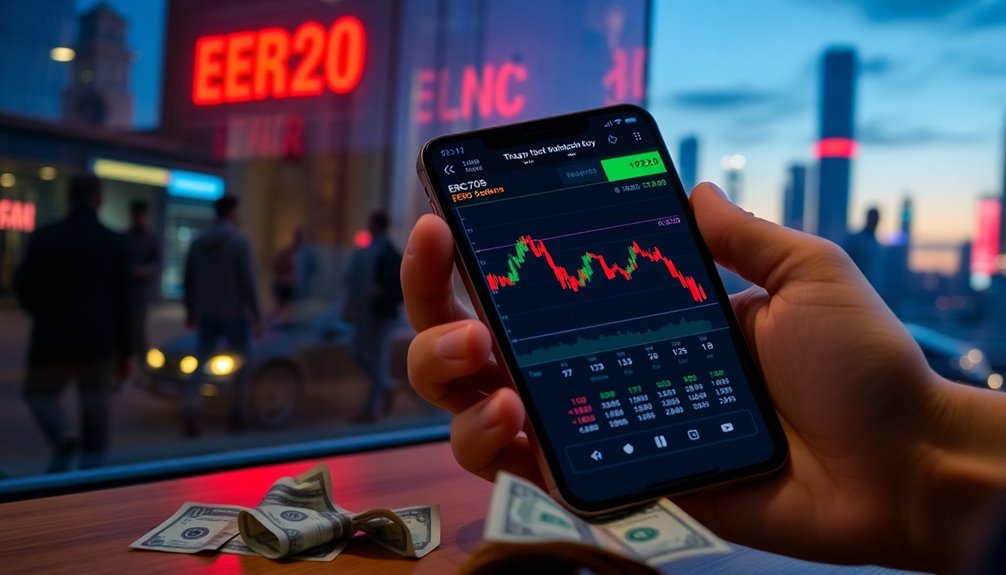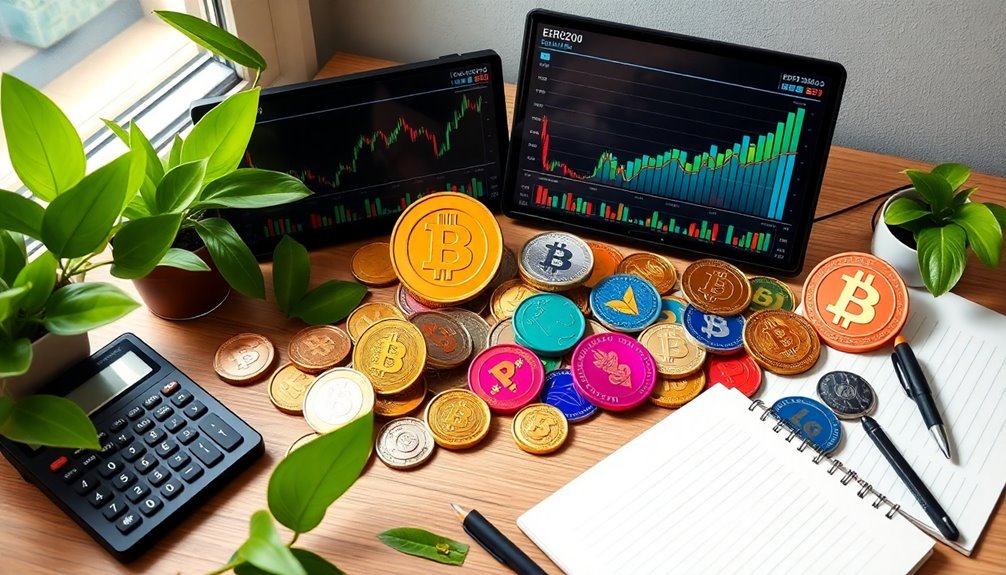ERC20 is a widely-used token standard that enables fungible tokens to operate seamlessly on the Ethereum blockchain. It defines essential functions like totalSupply, balanceOf, and transfer, ensuring your tokens can interact with various wallets and exchanges. This standard promotes interoperability, making it easier to create and manage tokens via smart contracts. While ERC20 tokens offer advantages like customization and enhanced liquidity, they also come with potential risks, such as security vulnerabilities and market volatility. If you're intrigued by the various aspects of ERC20 tokens, there's much more to uncover about their impact in the crypto world.
Key Takeaways
- ERC20 is a token standard on the Ethereum blockchain, enabling the creation of fungible tokens for various applications.
- It establishes mandatory functions for token transactions, such as totalSupply, balanceOf, and transfer.
- The standard ensures interoperability across wallets, exchanges, and decentralized applications.
- ERC20 tokens contribute to liquidity in the Ethereum ecosystem, enhancing decentralized finance (DeFi) and decentralized exchanges (DEXs).
- Smart contracts automate the creation and management of ERC20 tokens, ensuring secure and legitimate transactions.
Token Standard for Ethereum

The ERC20 token standard is a crucial framework that defines how fungible tokens operate on the Ethereum blockchain. This standard, proposed by Fabian Vogelsteller in 2015, addresses the need for consistency in creating and exchanging tokens, resolving the issues caused by a lack of standardization. By establishing a set of rules and functions, ERC20 ensures interoperability across various applications, wallets, and exchanges. Key mandatory functions like totalSupply, balanceOf, and transfer allow seamless token transactions. Optional features such as name, symbol, and decimals enhance usability. Additionally, ERC20 contributes to liquidity in the Ethereum ecosystem, boosting decentralized exchanges and increasing the ease of token exchanges.
ERC20 Token Overview

ERC20 tokens serve as the backbone of decentralized applications on the Ethereum blockchain, providing a standardized method for creating and managing fungible assets.
Key functions like TotalSupply, BalanceOf, and Transfer allow you to manage token supply and ownership efficiently. You can easily execute transfers, approve spenders, and check allowances, ensuring smooth transactions.
Optional features such as Name, Symbol, and Decimals offer customization for your token, while functionalities like Token Burning enhance scarcity.
These tokens represent various assets, from real estate to in-game items, and are integral in DeFi and DEXs. Their interoperability and accessibility make them easy to store and manage across wallets, fostering liquidity and security throughout the Ethereum ecosystem. Furthermore, ERC20 tokens adhere to a standard interface that ensures seamless integration across various platforms and applications.
Token Interactions via Smart Contracts

When creating and managing ERC-20 tokens, smart contracts play a crucial role in facilitating seamless interactions. They execute the token creation process on the Ethereum blockchain, defining total supply and managing distribution while enforcing rules for access and transfers. Smart contracts revolutionize blockchain technology by automating agreements and eliminating the need for intermediaries in contract execution.
Each transaction is automatically handled by smart contracts, ensuring security and efficiency. Functions like 'transfer', 'approve', and 'transferFrom' manage token movements and prevent unauthorized transactions, while events like 'Transfer' and 'Approval' help track them.
The standardized functions of ERC-20 tokens promote interoperability with various applications, such as exchanges and wallets, enhancing usability. Moreover, smart contracts ensure transaction legitimacy by checking balances and permissions, incorporating checks to secure interactions within the Ethereum ecosystem.
Pros and Cons

While exploring the pros and cons of ERC-20 tokens, you'll find that their advantages can significantly enhance your experience in the blockchain ecosystem.
They boast interoperability, allowing seamless communication with wallets, exchanges, and dApps, facilitating global transactions without middlemen. The standardization of ERC-20 tokens ensures compatibility and speeds up development, making it easier for you to anticipate how tokens will function. This interoperability among different ERC20 tokens not only builds user trust but also encourages token adoption across various platforms.
Flexibility and customization enable you to create various token types, meeting diverse use cases.
However, be cautious of security vulnerabilities that can lead to theft or scams. Additionally, scalability issues may result in high gas fees and slow transactions. Regulatory uncertainty also looms, affecting how tokens are perceived legally.
Balancing these pros and cons is crucial for your decision-making.
Token Performance Metrics

Understanding the performance metrics of tokens is vital for evaluating their potential and making informed decisions. You should pay attention to token distribution metrics like the Gini Coefficient and Richlist Balance, which reveal inequality and wealth concentration among holders. High concentration of funds in a small number of addresses indicates potential investment risk. Daily Active Users and Transfer Count help gauge user engagement and transaction activity, while Daily Volume and Latest Transfers provide insights into market dynamics. Market Cap and Circulating Supply give you an overview of the token's overall value and availability. Financial metrics like SOPR and MVRV assess investor performance, while capital flow metrics like Netflows can indicate market sentiment. By analyzing these metrics, you can better understand a token's performance and its prospects in the market.
Market Volatility Concerns

Market volatility is a critical concern for investors navigating the ERC-20 token landscape, especially as economic factors and institutional behaviors shape market dynamics.
Interest rate decisions by the U.S. Federal Reserve can create uncertainty, impacting the performance of cryptocurrencies, including ERC-20 tokens.
When institutional investors spread their investments across various tokens, it influences market volatility and liquidity.
You'll notice that as volatility increases, trading volume often spikes by about 5%, prompting you to adjust your strategies and focus on risk management. Additionally, recent data shows that while some tokens may show resilience, like Bitget's BGB, others like Ethereum can decline.
Staying informed about economic indicators and institutional movements is crucial for making sound investment decisions in this unpredictable environment.
Emergence of Layer 2 Solutions

As blockchain technology evolves, Layer 2 solutions have emerged as vital enhancements, addressing the scalability and efficiency challenges faced by Layer 1 networks like Ethereum.
These technologies are built on top of existing blockchains to improve transaction speed and reduce costs. They process transactions off-chain or in optimized ways, batching them for recording on the main chain, which helps alleviate congestion. Layer-2 solutions function like an elevated expressway over a congested highway, allowing for higher throughput compared to Layer-1 alone.
For instance, rollups bundle multiple transactions, while state channels facilitate off-chain interactions. This leads to quicker confirmations and lower fees, making micro-transactions feasible.
Layer 2 solutions maintain the security of the underlying blockchain, paving the way for broader adoption and innovative applications in the Web3 ecosystem.
They're essential for maximizing the potential of decentralized applications and networks.
Diversify Token Holdings Strategically

To effectively navigate the volatile world of cryptocurrencies, diversifying your token holdings is essential for managing risk and maximizing potential returns.
Start by mixing low-risk and high-risk assets to create a balanced portfolio. Incorporate stablecoins like USDT or USDC to stabilize volatility. Diversification strategies are crucial for protecting future returns and promoting a more balanced risk-reward profile in crypto portfolios.
Don't forget to allocate some funds to high-growth assets, such as DeFi protocols or emerging blockchain solutions.
Consider including privacy coins for privacy needs, staking coins for passive income, and utility tokens for specific uses within the ecosystem.
Explore industry diversification by investing in sectors like DeFi, exchanges, and NFTs.
Finally, utilize token baskets or index tokens to simplify diversification and automate management, ensuring liquidity for quick transactions when needed.
Frequently Asked Questions
How Do I Create My Own ERC20 Token?
To create your own token, start by defining its purpose and gathering necessary resources.
Choose a name, symbol, and initial supply while deciding on features and circulation rules.
Next, develop the smart contract using Solidity, including functions like 'approve' and 'transfer.'
Test and audit the contract for any issues before deploying it on the Ethereum network.
Finally, ensure compatibility with other applications in the ecosystem for a smooth launch.
What Programming Languages Are Used for ERC20 Tokens?
Creating ERC20 tokens is like crafting a unique recipe; you need the right ingredients. For this, you'd primarily use Solidity, the language designed for Ethereum smart contracts.
If you're comfortable with JavaScript or similar languages, you'll find it accessible. Additionally, tools like Brownie can help manage your development process, while OpenZeppelin provides pre-written code for security.
Together, they make your token creation smoother and more efficient.
Can ERC20 Tokens Be Converted to Other Token Standards?
You can't directly convert ERC-20 tokens to other token standards, but you can use cross-chain bridges to swap them for tokens on different networks.
This process doesn't change the original token's properties; it simply allows you to use it on another blockchain.
If you want to shift to a new standard, like ERC-721, you'd need to create a new token entirely, keeping the original ERC-20 token functional on Ethereum.
How Are ERC20 Tokens Stored Securely?
Storing your tokens securely can feel like fortifying a digital fortress!
To keep your assets safe, use decentralized wallets where your private keys stay on your device. Implement two-factor authentication for extra protection, and make sure you're updating your software regularly.
Always conduct transactions over secure networks. Consider using hardware wallets for offline storage, and don't forget to securely record your recovery phrases—these are your golden tickets to regaining access!
What Are the Most Popular ERC20 Tokens Currently?
Right now, some of the most popular tokens include USD Coin (USDC) for its stability, Uniswap (UNI) for decentralized trading, and Chainlink (LINK) for its data connectivity.
You'll also find Maker (MKR) influential in DeFi, while Mantra DAO (OM) has seen remarkable growth.
Don't overlook ApeCoin (APE) in the NFT space or Yeti Ouro, which focuses on gaming.
Each token has unique features that appeal to different investors and users.
Conclusion
In the world of Ethereum, ERC20 tokens are like the vibrant colors on an artist's palette—each one brings its unique flair to the canvas of blockchain. Just as a painter carefully chooses their shades, you should strategically diversify your token holdings, balancing risk and reward. Remember, the crypto market can be as unpredictable as a stormy sea, so stay informed and adjust your sails when needed. Embrace the journey, and let your investment strategy reflect your vision!









